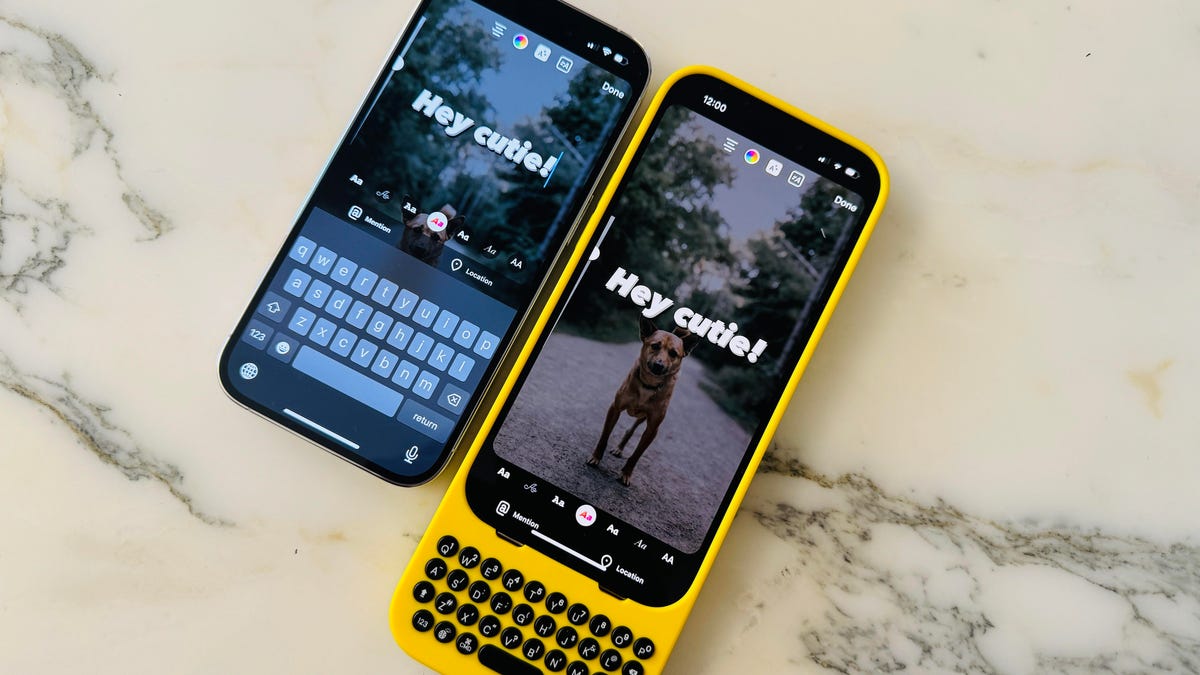Folding, AI and Gaming Phones: The Most Eye-Catching Mobile Tech at CES 2024
There was plenty of movement in the mobile world to get excited about at the world's largest tech show. Here's what you should know about.

The Clicks iPhone Pro case swaps out your digital keyboard for a physical one, giving you far more screen space when typing.
CES 2024 is an annual parade of flashy tech gadgets, from see-through TVs and other innovative concepts we wish were real today, to practical products you can buy right now. Then there's the downright bizarre. As expected, AI is everywhere.
Here are the mobile gadgets that piqued our imaginations so far at the show. We'll keep our eyes peeled for more as we continue to rove the world's largest tech conference.
Samsung Flex In & Out Flip concept phone
Samsung seems to be reimagining the future of its clamshell-style lineup. The company's new Flex In & Out concept phone is similar to the Galaxy Z Flip 5, except you can fold it in both directions. It can be folded open, folded shut and bent over backwards to turn the screen into an outer display.
Instead of a cover screen, the 360-degree folding display allows you to interact with content on the screen even when it's folded. It could replace the need for a cover screen, and it has left us asking whether this flexible display will eventually make its way to the Galaxy Flip lineup.
Asus ROG Phone 8
The Asus ROG Phone 8 Pro gives a lot of importance to horizontal gameplay.
The Asus ROG line is a series of smartphones designed for gamers. The latest model, the Asus ROG Phone 8, once again comes with the top-tier specs that we've come to expect from this lineup. The 6.78-inch phone is powered by a Qualcomm Snapdragon 8 Gen 3 processor and serves up the option of 24GB of RAM and 1TB of storage in the Pro model for those who want extra juice.
To make sure gameplay runs as smoothly as possible, this phone has an ultrafast refresh rate of 165Hz and a 5,500 mAh battery that supports 65-watt fast charging. Because of its audience, the Asus ROG Phone 8 Pro still puts a lot of emphasis on how the phone works horizontally for gameplay, including sensors that can function like shoulder buttons.
Going beyond gameplay, this phone also gets some AI-based features such as semantic search and noise canceling. The Asus ROG Phone 8 starts at $1,100 and is expected to be released within the first quarter of this year in the US.
TCL 50 XL NxtPaper 5G
The TCL 50 XL NxtPaper 5G is one of two US-bound phones that will feature TCL's paperlike display.
The TCL 50 XL NxtPaper 5G is a smartphone that's designed to be easier on your eyes. It has a 6.8-inch display that uses reflective screen technology similar to e-paper displays. The company claims it filters blue light by up to 61%. The display has a normal view for general use, a low-contrast color paper mode for comics and a black-and-white mode to act more like an e-reader. A stepdown model, the TCL 50 XE NxtPaper 5G, is also coming with a smaller 6.6-inch display.
While this tech isn't new to its phone (the company launched two phones last year with it), TCL's first NxtPaper phones for the US market are launching as part of its broader TCL 50 series phone lineup.
Rabbit R1 AI device
There are no actual apps on the R1; instead, you press a physical push-to-talk button to launch a music playlist or book a taxi as if you were speaking into a walkie-talkie.
AI devices hoping to reduce (or eliminate) the need for smartphones are coming. The Rabbit R1 is a $199 AI gadget that wants to be a better personal assistant than your phone. It's like if you had your friend order takeout for you rather than doing it to yourself, the company's CEO said. The Rabbit RI apparently achieves this by swapping out apps for a push-to-talk button and an operating system that can learn how to use apps on your behalf.
The company says the device can execute tasks such as scheduling appointments, setting reminders and sending messages. The hardware it relies on includes a 2.88-inch display, a camera, 128GB of storage and 4GB of RAM. It runs on a 2.3GHz MediaTek Helios P35 processor. The Rabbit R1 is expected to ship in late March.
Clicks keyboard for iPhone
The Clicks iPhone Pro case swaps out your digital keyboard for a physical one, giving you far more screen space when typing.
CES tends to showcase the gadgets of the future, but the Clicks keyboard case for iPhones is a nod to the past. The $139 iPhone case, from Clicks Technology, literally swaps out your digital keyboard for a physical one. It features a retro keyboard with real buttons that click when pressed, serving up the tactile smartphone experience many old-schoolers crave. The Clicks keyboard is compatible with the iPhone 14 Pro or iPhone 15 Pro and Pro Max, and no charging is required.
Doublepoint remote control concept for WearOS
Our first look at Doublepoint concept software on an Android watch.
Imagine being able to dim the living room lights with a turn of the wrist. Or browse Netflix with a few taps of your fingers. Finnish startup Doublepoint's new software can turn an Android watch into a remote control for any device via a Bluetooth connection. It's up to developers and app-makers to decide what a small gesture like tapping fingers or rotating your wrist will actually do, but it still offers exciting possibilities. The software for WearOS watches is expected to drop within the first half of this year.

